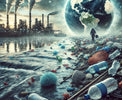
The Devastating Impact of Overproducing Plastics
, by Planet Green, 4 min reading time

, by Planet Green, 4 min reading time
Plastics pollute throughout their entire life cycle, from extraction as fracked gas and oil to production at petrochemical factories, through their use in consumer products, and finally their disposal, recycling, and/or escape into the environment. In the United States, plastic production predominantly occurs in low-wealth communities throughout the Gulf South and Ohio River Valley, poisoning the air and water for nearby residents.
The Lifecycle of Plastic Pollution
The process of creating plastics starts with petrochemicals derived from fossil fuels like coal, oil, and gas. These petrochemicals are the building blocks of plastics, as well as synthetic fertilizers and pesticides. Plastic pollution impacts the environment at every stage—from the extraction of oil and gas to manufacturing at petrochemical plants, to consumer goods and packaging, and finally, disposal or accidental release into the environment.
During production, a flurry of hydraulic fracturing (fracking) chemicals are pumped deep into the earth to release fossil gas, which is then separated into methane and different natural gas liquids. The liquid ethane is processed into ethylene at a “cracker” facility, releasing toxic air pollution and greenhouse gases. The final product, tiny polyethylene balls called nurdles, are the building blocks of many plastic products. Nurdles often escape during production and transport, polluting rivers, oceans, and soil. These nurdles are then combined with various other toxic chemicals to produce different types of plastic materials.
Health and Environmental Impacts
Plastic pollution affects our food, water, air, and bodies. Plastics are resistant to biodegradation, breaking into smaller pieces that carry toxic chemicals throughout the environment—from the depths of the Marianas Trench to the heights of Mount Everest. When consumers use plastic containers, the chemicals and microplastics leach into our bodies, posing serious health risks. Plastics continue to emit greenhouse gases as they degrade, exacerbating climate change.
In the United States, plastic manufacturing is centered in the Gulf South and the Ohio River Valley, areas already burdened by other industries and acute pollution exposure. For instance, Formosa Plastics plans to build a $12 billion petrochemical facility in St. James Parish, Louisiana. This facility, deceptively named the ‘Sunshine Project,’ would release 800 tons of toxic air pollution and 13.6 million tons of greenhouse gases annually in an area known as “Cancer Alley” due to its high cancer rates.
The Role of Ink Cartridge Production and Third-Party Manufacturers
The issue of plastic pollution extends to the production of ink cartridges, particularly those manufactured by third-party companies in China. These cartridges often utilize low-quality plastics and are produced in factories with minimal environmental regulations, leading to significant waste and pollution. The production process creates vast energy waste, releases harmful chemicals and greenhouse gases further contributing to the global plastic pollution crisis.
Once used, these cartridges add to the mounting e-waste problem. Many end up in landfills, where they break down into microplastics that pollute the soil and waters s many as 1 million cartridges per day in the Un tied States alone. The recycling rates for these cartridges are dismally low, exacerbating the environmental impact. By opting for US remanufactured or reclaimed cartridges, like those at www.planetgreenrecycle.com, consumers can significantly reduce their plastic waste footprint.
Petrochemicals and Climate Change
The petrochemical industry consumes more energy than any other industry worldwide. In the U.S., petrochemical facilities produce as much greenhouse gas pollution as 116 coal-fired power plants. Plastics also release greenhouse gases when exposed to sunlight, continuing to impact climate change throughout their long existence.
People living near petrochemical plants suffer the most from the effects of plastic pollution, but the issue is far-reaching. Single-use plastic products break down into microplastics that contaminate our food, water, and bodies. Microplastics have been found in breast milk and placentas, and the chemicals in plastics are linked to numerous health problems, from cancers to reproductive harm. PFAS chemicals, also known as forever chemicals, have been found in rainwater and human bloodstreams worldwide.
What Can We Do?
To address the plastic pollution crisis, we must take action at multiple levels:
Stopping the production of new plastics is crucial for curbing the plastic pollution crisis. By taking collective action, we can protect our environment and health from the pervasive impacts of plastic pollution.

Pinellas County, Florida, has taken a significant step in combating plastic waste by adding Planet Green Recycle to its public-facing information website. Residents and businesses...

The Holiday Spirit Meets Sustainability The holiday season is a time for giving, celebrating, and creating memories. It’s also a time when we tend to...

With November 15th being celebrated as America Recycles Day, the Plastics Industry Association (PLASTICS) commemorates Recycling Week this year from November 11th through November 15th...

Plastic pollution has become one of the most pressing environmental issues of our time, impacting land, waterways, and marine life on a global scale. While...